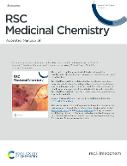Enhancing the Antimycobacterial Efficacy of Pyridine-4-Carbohydrazide: Linkage to Additional Antimicrobial Agents via Oxocarboxylic Acids

Autor
Stolaříková, Jiřina
Datum vydání
2025Publikováno v
RSC Medicinal ChemistryNakladatel / Místo vydání
Royal Society of ChemistryRočník / Číslo vydání
16 (2)ISBN / ISSN
ISSN: 2632-8682ISBN / ISSN
eISSN: 2632-8682Informace o financování
UK//COOP
MSM//LX22NPO5103
MZ0//NW24-05-00539
Metadata
Zobrazit celý záznamTato publikace má vydavatelskou verzi s DOI 10.1039/D4MD00663A
Abstrakt
This study evaluates the antimycobacterial potential of novel "mutual" bioactive amides, combining pyridine-4-carbohydrazide (isoniazid, INH) with various antimicrobial agents (sulphonamides, 4-aminosalicylic acid, thiosemicarbazide, diphenyl (thio)ethers) via oxocarboxylic acids. The aim was to enhance activity against both drug-susceptible and multidrug-resistant (MDR) Mycobacterium tuberculosis and non-tuberculous strains, while overcoming drug resistance through dual-action mechanisms. Many derivatives exhibited potent antimycobacterial activity, with minimum inhibitory concentrations (MICs) as low as <= 0.25 mu M, outperforming INH, especially diphenyl (thio)ethers and biphenyl analogues. Additionally, the compounds were effective against M. kansasii (MICs <= 1 mu M) and inhibited MDR strains at higher concentrations (>= 8 mu M). The cytotoxicity assay indicated a favourable safety profile, with no significant haemolysis at 125 mu M, and some compounds were even protective. Selectivity for mycobacteria was confirmed by low inhibition of Gram-positive bacteria and inactivity against Gram-negative bacteria or fungi, highlighting the potential for further development as antimycobacterial agents.
Klíčová slova
amides, antimycobacterial activity, diphenyl ethers, hydrazones, isoniazid, molecular hybridization, sulphonamides
Trvalý odkaz
https://hdl.handle.net/20.500.14178/2671Licence
Licence pro užití plného textu výsledku: Creative Commons Uveďte původ 3.0 Unported







